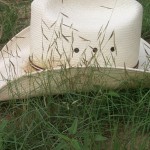Red Grama
Bouteloua trifida
Poaceae
Description
This grass is tufted with erect (when young) or prostrate (at maturity) stems growing from short rootstocks. Older plants tend to be somewhat rhizomatous. The mostly basal leaves are short and narrow, about only 1.5 mm wide but up to 10 cm in length. The sheaths are shorter than the dark and naked internodes. Upper stem leaves are greatly reduced. The stems have two to seven persistent, pectinate spikes that are red or purplish in color. Each spike carries about 12 to 24 spikelets. The spikelets have three short, rough awns. Red Grama is a perennial, warm-season, native reaching 4.5 to 16 inches or 12 to 40 cm tall. It flowers in response to moisture and temperature and produces seeds from April to November. It provides poor grazing for both livestock and wildlife. It does not produce much forage; however, all livestock will graze what forage is available.Habitat
Red Grama grows on upland hills and ridges on shallow soils. It increases in overgrazed ranges. It is a common grass in the western half of our state. It persists under heavy grazing and low moisture because its growth area and basal leaves are so close to the ground that livestock simply cannot get to more than 50% of the plant tissue. While it becomes dormant in summer, it responds quickly to rainfall.Images
Plant Characteristics
Duration: Perennial
Stem Texture: Hairless/Smooth
Growth Habit: Bunch grass, Grasses
Season: Warm
Distribution
 : 02 - Gulf Prairies and Marshes, 03 - Post Oak Savannah, 05 - Cross Timbers and Prairies, 06 - South Texas Plains, 07 - Edwards Plateau, 08 - Rolling Plains, 09 - High Plains, 10 - Trans-Pecos
: 02 - Gulf Prairies and Marshes, 03 - Post Oak Savannah, 05 - Cross Timbers and Prairies, 06 - South Texas Plains, 07 - Edwards Plateau, 08 - Rolling Plains, 09 - High Plains, 10 - Trans-Pecos
Distributions
Distribution refers to the ecological region in Texas that a plant has been found. You can also view a clickable map.
Book: Know Your Grasses (B-182)
Collection: Grasses



